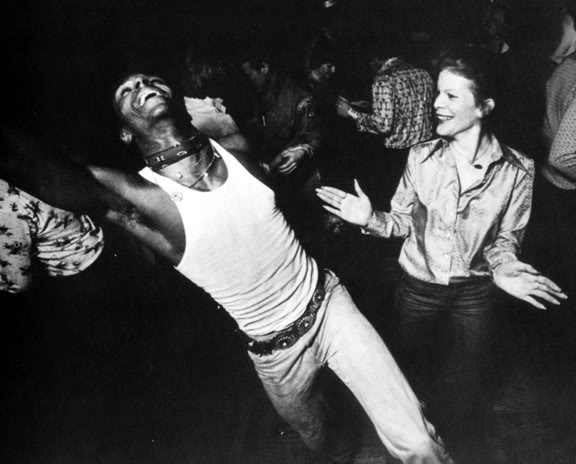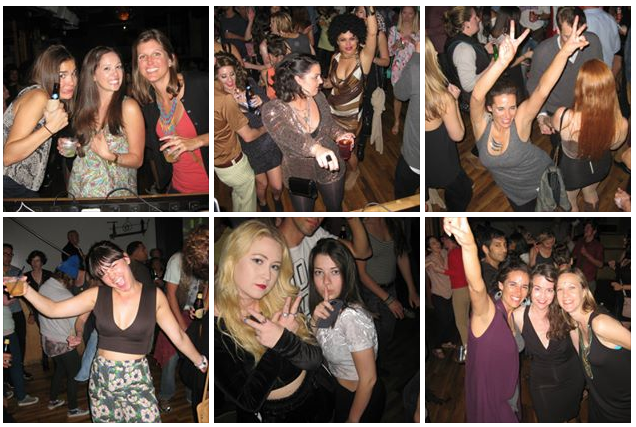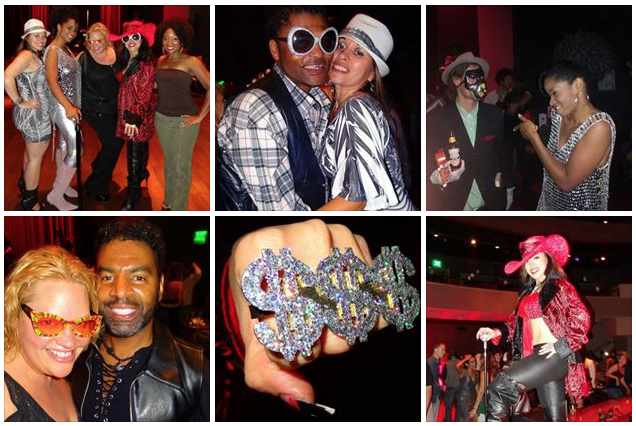
STOMP!
disco and funk music party
next date:
Friday, September 7th, 2018 at Resident in Los Angeles
428 S Hewitt St - downtown L.A. / 9pm-2am / $10-$15 / 21+
Facebook Event Page / Tickets
Join our Facebook Page and meet other disco + funk fans

photos from the 4/11/14 party at Public Works SF

photos from the 10/20/12 launch party at Yoshi's SF
Funkytown Radio Show : Episode #1
01. I Just Want To Be - Cameo
02. Joystick - Dazz Band
03. A Lovers Holiday - Change
04. Stomp! - The Brothers Johnson
05. Somebody Else's Guy - Jocelyn Brown
06. Just Be Good To Me - The S.O.S. Band
07. Disco Dancin' (DJ Agent 86 remix) - A Taste of Honey
08. We Got More Soul - Dyke and The Blazers
09. 17 - Rick James
10. California Love - Roger & Zapp
11. Chase Me - Con Funk Shun
FUNK
from Wikipedia, the free encyclopedia
Funk is an American music genre that originated in the late 1960s when African
American musicians blended soul music, soul jazz and R&B into a rhythmic,
danceable new form of music. Funk de-emphasizes melody and harmony and brings
a strong rhythmic groove of electric bass and drums to the foreground. Funk songs
are often based on an extended vamp on a single chord, distinguishing it from
R&B and soul songs centered around chord progressions.
Like much African-inspired music, funk typically consists of a complex groove
with rhythm instruments such as electric guitar, electric bass, Hammond organ,
and drums playing interlocking rhythms. Funk
bands sometimes have a horn section of several saxophones, trumpets, and in some
cases, a trombone, which plays rhythmic "hits".
Many of the most famous bands in the genre also played disco and soul extensively.
Funk music was a major influence on the development of disco music, and funk samples
were present in most styles of house music. It is also the main influence of go-go.
Funk creates an intense groove by using strong bass guitar riffs and bass lines.
Like Motown recordings, funk songs used bass lines as the centerpiece of songs.
Slap bass' mixture of thumb-slapped low notes and finger "popped" (or
plucked) high notes allowed the bass to have a drum-like rhythmic role, which
became a distinctive element of funk. Some of the best known and most skillful
soloists in funk have jazz backgrounds. Trombonist Fred Wesley and saxophonist
Maceo Parker are among the most notable musicians in the funk music genre, with
both of them working with James Brown, George Clinton and Prince. Some 1960s/70s
funk bands are Kool & The Gang, Tower Of Power, Earth, Wind & Fire, The
Blackbyrds, The Ohio Players, or The Brothers Johnson.
Funk utilized the same extended chords found in bebop jazz, such as minor chords
with added sevenths and elevenths, or dominant seventh chords with altered ninths.
However, unlike bebop jazz, with its complex, rapid-fire chord changes, funk virtually
abandoned chord changes, creating static single chord vamps with little harmonic
movement, but with a complex and driving rhythmic feel.
The chords used in funk songs typically imply a dorian or mixolydian mode, as
opposed to the major or natural minor tonalities of most popular music. Melodic
content was derived by mixing these modes with the blues scale. In the 1970s,
jazz music drew upon funk to create a new subgenre of jazz-funk, which can be
heard in recordings by Miles Davis (On The Corner) and Herbie Hancock (Head Hunters).
In funk bands, guitarists typically play in a percussive style, often using the
wah-wah sound effect and muting the notes in their riffs to create a percussive
sound. Guitarist Ernie Isley of The Isley Brothers and Eddie Hazel of Funkadelic
were notably influenced by Jimi Hendrix's improvised solos. Eddie Hazel, who worked
with George Clinton, is one of the most notable guitar soloists in funk. Ernie
Isley was tutored at an early age by Jimi Hendrix himself, when he was a part
of The Isley Brothers backing band and lived in the attic temporarily at the Isleys'
household. Jimmy Nolen and Phelps Collins are famous funk rhythm guitarists who
both worked with James Brown.
The distinctive characteristics of African-American musical expression are rooted
in West African musical traditions, and find their earliest expression in spirituals,
work chants/songs, praise shouts, gospel and blues. In more contemporary music,
gospel, blues and blues extensions and jazz often flow together seamlessly. Funky
music is an amalgam of soul music, soul jazz and R&B.
James Brown and others have credited Little Richard's saxophone-studded, mid-1950s
road band as being the first to put the funk in the rock'n'roll beat. Following
his temporary exit from secular music to become an evangelist, some of Little
Richard's band members joined Brown and the Famous Flames, beginning a long string
of hits in 1958.
DISCO
from Wikipedia, the free encyclopedia
Disco is a genre of dance music
whose popularity peaked during the middle to late 1970s. It had its roots in
clubs that catered to African American, Gay and psychedelic and other communities
in New York City and Philadelphia during the late 1960s and early 1970s. Disco
was a reaction by New York City's gays as well as black and Latino heterosexuals
against both the domination of rock music and the demonetization of dance music
by the counterculture during this period. While disco was a form of black commercial
pop music, it was, however, dominated by white — and presumably heterosexual
— men. Women embraced disco as well, and the music eventually expanded
to several other popular groups of the time. In what is considered a forerunner
to disco style clubs, in February 1970, the New York City DJ David Mancuso opened
The Loft, a members-only private dance club set in his own home. Most agree
that the first disco songs were released in 1973, though some claim Manu Dibango's
1972 Soul Makossa to be the first disco record. The first article about disco
was written in September 1973 by Vince Aletti for Rolling Stone Magazine. In
1974 New York City's WPIX-FM premiered the first disco radio show.
Musical influences include funk, Latin and soul music. The disco sound has soaring,
often reverberated vocals over a steady "four-on-the-floor" beat,
an eighth note (quaver) or sixteenth note (semi-quaver) hi-hat pattern with
an open hi-hat on the off-beat, and a prominent, syncopated electric bass line
sometimes consisting of octaves. The Fender Jazz Bass is often associated with
disco bass lines, because the instrument itself has a very prominent 'voice'
in the musical mix. In most disco tracks, strings, horns, electric pianos, and
electric guitars create a lush background sound. Orchestral instruments such
as the flute are often used for solo melodies, and unlike in rock, lead guitar
is rarely used.
Well-known late 1970s disco performers included Donna Summer, Amanda Lear, The
Bee Gees, KC and the Sunshine Band, Chic, and The Jacksons. Summer would become
the first well-known and most popular disco artist, giving her the title 'The
Queen of Disco', and also played a part in pioneering the electronic sound that
later became a part of disco (see below). While performers and singers garnered
the lion's share of public attention, the behind-the-scenes producers played
an equal, if not more important role in disco, since they often usually wrote
the songs and created the innovative sounds and production techniques that were
part of the "disco sound". Many non-disco artists recorded disco songs
at the height of disco's popularity, and films such as Saturday Night Fever
and Thank God It's Friday contributed to disco's rise in mainstream popularity.
According to music writer Piero Scaruffi the disco phenomenon spread quickly
because the "collective ecstasy" of disco was cathartic and regenerative
and lead to freedom of expression. Disco was the last mass popular music movement
that was driven by the baby boom generation.
An angry backlash against disco music and culture emerged in the United States
hitting its peak with the July 1979 Disco Demolition Night riot. While the popularity
of disco in the United States declined markedly as a result of the backlash,
the genre continued to be popular elsewhere during the 1980s.
Because the term "disco" became unfashionable at the start of the
1980s it was replaced by "dance music" and "dance pop" which
described music powered by the basic disco beat. In the decades since, dance
clubs have remained highly popular, and the disco beat has informed the sound
of many of music's biggest stars. Disco has been influential on several dance
music genres that have emerged since, such as House, Nu-Disco, Hi-NRG, Italo
Disco, Eurodisco, Disco-Funk and Latin Freestyle.


